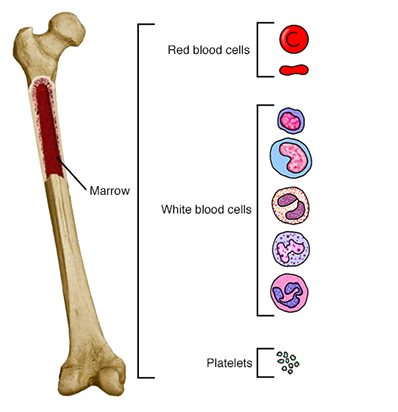Leukemia: Introduction
What is cancer?
Cancer starts when cells in the body change (mutate) and grow out of control. Your body is made up of tiny building blocks called cells. Normal cells grow when your body needs them. They die when your body doesn't need them anymore. Cancer is made up of abnormal cells that grow even though your body doesn’t need them. In most types of cancers, the abnormal cells grow to form a lump or mass called a tumor.
Leukemia is different from most other cancers. Leukemia is a cancer of the blood. This cancer starts in the bone marrow. The bone marrow is the thick, spongy liquid inside your bones. It's where new blood cells are made. Leukemia takes over the bone marrow and the abnormal cells spill out into the circulating blood.
Leukemia starts in early (or immature) forms of blood cells. Most leukemias make abnormal white blood cells, which, when healthy, help to fight infections. When you have leukemia, your body makes too many "bad" blood cells that don’t work like they should. Instead of forming tumors, leukemia cells travel in the blood and go all over the body. This means they can reach almost any organ. Leukemia can cause problems and be found in many different ways, depending on which organs are affected. What all types of leukemia tend to have in common is abnormal blood cell counts with increased immature blood cells in circulation.
What are normal blood cells?
Blood is made up of liquid, called plasma, and 3 main kinds of cells. Each kind of cell has a special task:
-
White blood cells. These help the body fight infection and disease.
-
Red blood cells. These carry oxygen from the lungs to the body's tissues and carry carbon dioxide from the tissues to the lungs.
-
Platelets. These help form blood clots and control bleeding.
Blood cells are made in the soft center of the bones called the bone marrow. In adults, active bone marrow is found mostly in the hip bones, ribs, spine, and skull. Normal cells in the bone marrow develop from very immature cells into mature, working cells ready to go out in the blood. Early, less mature, nonworking forms of new blood cells are called blasts.
As cells mature in the bone marrow, they become smaller and more compact. They mature so they're better able to do their special jobs. Some new blood cells stay in the bone marrow to grow and give rise to other new blood cells. Mature blood cells make up the normal blood and travel to other parts of the body as needed. More blood cells are made when the body needs them, such as when a person has an infection or low numbers of red blood cells (anemia). This process keeps the body healthy and in balance.

What are leukemia cells?
When a person has leukemia, the body makes too many nonworking blood cells of one type. These abnormal cells, most often white blood cells, don't mature and look different from normal blood cells. They don't work as they should. They also crowd the bone marrow so it can't make other blood cells, often red blood cells and platelets. This leads to low red cell count (anemia), increased bleeding (low platelets) and increased infections (abnormal white blood cells).
Types of leukemia
Two types of abnormal blood cell lines can turn into leukemia: lymphoid cells and myeloid cells.
-
When leukemia involves the lymphoid cells, it's called lymphocytic or lymphoblastic leukemia.
-
When it starts in the myeloid cells, it's called myelogenous or myeloid leukemia.
Leukemias are also grouped based on how fast they grow:
In acute leukemia, the abnormal blood cells are often young cells (immature blasts) that don't work the way they should. These cells grow quickly. Acute leukemia often needs to be treated right away.
In chronic leukemia, young blood cells are present. But mature, functional cells are also made. In chronic leukemia, blasts grow slowly. It takes longer for the disease to get worse. In some cases, treatment can be delayed until it gets worse or starts causing problems.
These categories result in 4 combinations, which make up the main types of leukemia:
-
Acute lymphoblastic (lymphocytic) leukemia (ALL). ALL is the most common type of leukemia in children. But it can occur in adults.
-
Acute myeloid (myelogenous) leukemia (AML). AML is the most common type of acute leukemia in adults. It can also occur in children.
-
Chronic lymphocytic leukemia (CLL). CLL is more common in older adults. It may be seen in younger adults, but almost never in children.
-
Chronic myelogenous (myeloid) leukemia (CML). CML is seen mostly in adults. Very few children develop this type of leukemia.